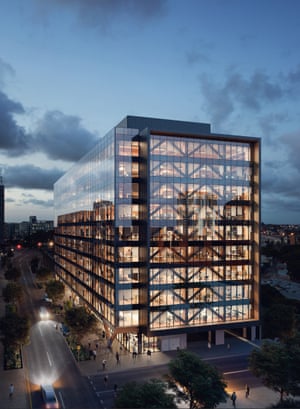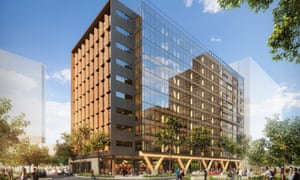The famous Queenslander tradition of building houses upon wooden stilts is escalating to a whole other level on Thursday – or 10 levels, to be exact.
The sod-turning ceremony at 5 King Street in Brisbane will be a groundbreaking event in more than just in the literal sense. When complete in 2018, 45 metres of the 52-metre office tower will qualify as the world’s highest to be held aloft not by steel and concrete, but timber and glue.
The project is the latest of a flurry of engineered wood towers in Australia using solutions such as cross-laminated timber (CLT), the load-bearing material on projects such as StrongBuild’s The Gardens Macarthur affordable housing project in Campbelltown. Sydney’s International House at Barangaroo is constructed from CLT and the similar Glulam method.
According to Chris Ammundsen, the Aurecon lead structural engineer behind 5 King Street, the CLT process involves glueing thick layers of wood together with the grain alternating at 90 degree angles.
“Using timber as the primary structural load-bearing element creates interesting questions during the design process of any building,” he says.
“For example; how might we minimise the risk of chainsaw attack?”
Ammundsen has a lot riding on the answers he came up with – his company is setting up office within the building in order to enjoy the benefits of working in timber surrounds, which a PlanetArk study indicated can lead to a lower heart rate and blood pressure.
There are also environmental benefits – where every tonne of cement creates 900kg of greenhouse gas emissions, engineered wood acts instead as a carbon sink.
The GBCA (Green Building Council of Australia) last year updated its Green Star accreditation to incentivise CLT, which chief executive Romilly Madew says: “provides great thermal performance, which means they are efficient to heat and cool and save considerable amounts on utility bills.”
An RMIT Lifecycle Assessment study conducted on Australia’s first timber high-rise completed in 2013, Lend Lease’s 10-storey Forte building in Melbourne, concluded it would generate 22% lower global warming emissions over its lifespan than a traditional concrete build.
The construction site for engineered timber projects also generates less noise pollution, and the structures can be erected much faster with fewer workers: Lend Lease claims it will cut six weeks off the construction time of 5 King Street by using timber.

That’s because they are assembled like supersized flatpack furniture, says Nick Hewson, a technical manager with engineered wood suppliers XLam.
“There’s a speed and simplicity in construction,” he says. “Think of assembling a big piece of furniture – there are even oversized screws and slats.”
He says the radically different building style is one of the main barriers to the growth of CLT in Australia, where a construction industry used to grappling with each project requirement as it arises instead needs to revamp workflows to ensure everything is on-site ready to go from day one. Anyone who has assembled an Ikea bookshelf can attest that a single piece missing from a flatpack can result in construction delays, structural deficiencies, and even desperate attempts to decipher oblique Swedish instruction manuals.
Just like Ikea products, CLT components need to be shipped in all the way from Europe, where modern engineered timber techniques were first developed and are far more widely used.
To address this, XLam is building Australia’s first engineered wood factory just outside Albury Wodonga, a town that sits on the border between Victoria and NSW and will be able to service both major metropolitan markets once it is operational early next year.
A UN annual review in 2015-16 found that production of CLT is expanding globally from 650,000 to 700,000 cubic metres in 2015 to a projected 1 million cubic metres last year, but concrete remains well ahead.
Safety is another obstacle to growth. As last week’s Grenfell Tower apartment block blaze in London so tragically illustrated, incorporating flammable materials into building design can be fatal – so isn’t adding wood into the mix a recipe for disaster?
Hewson says that when Australia’s building code changed last year to allow for medium-rise timber buildings, the rules were based on requiring sprinklers in buildings and cladding in fire-rated plasterboard – a measure he conceded would lessen the psychological benefits of exposed wood in buildings. Where architects don’t want to cover the wood in plasterboard, an alternative is using timber thick enough to self-protect.
“[With thick wood] you can subject it to long periods of fire exposure, it starts to char which insulates the material inside. It can burn through slowly but maintain its strength,” he says.
Ken Slattery, the chief executive of Cement Concrete and Aggregates Australia, has a simple observation to make in response to the new competition: “concrete doesn’t burn”.
He says that concrete remains the most-used building material on earth as it is flexible, durable and long-lasting.
The rise of CLT offers another approach that builds upon the strengths of concrete in a quite literal sense – engineered wood extensions slapped on top of existing buildings, as seen in the use of XLam timber in a 10-storey hotel being built on top of a six-storey office block in Melbourne’s Southbank.
According to Hewson, the fact CLT is 20% lighter than concrete allowed extra room to grow for the Adina Apartment Hotels project, due to start construction later this year for completion in 2018. He says: “A lot of buildings from the 50s and 60s are looking a bit tired, and owners want to rejuvenate - so why not vertical extensions?”

